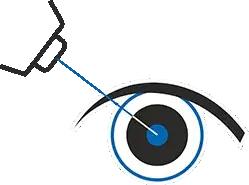Procedure of PRK
The steps involved in PRK eye surgery (reshaping of the cornea through an excimer laser to correct refractive mistakes like myopia, hyperopia, and astigmatism).
The steps of the PRK vision surgery are as follows:
1. Pre-Operative Preparation
Before performing PRK eye surgery, each patient is carefully examined by an ophthalmologist or refractive surgeon to ensure that they are a suitable candidate for his treatment. Such examination includes:
- The corneal health, size of the pupil, and measurement of refractive.
- Medical History of any previous ophthalmic disorders, past surgical procedures, medications, and systemic diseases to evaluate eligibility for surgery.
2. Then, the surgeon gives you anesthesia with eye drops on the day of surgery to make the procedure completely painless. Some doctors may also use a mild sedative to relax the patient.
3. Epithelial Removal- the corneal outer layer exposes the underlying corneal tissue. There are two common ways of removing the epithelium in PRK lasik: alcohol solution and mechanical brush.
4. Laser Reshaping- After the epithelium removal, an excimer laser is used to reconfigure the corneal curvature based on the patient's precise measurements for refractive error. The high precision of the excimer laser ensures minimal damage to surrounding tissue.
5. Immediately after the laser treatment, a temporary soft contact lens or a bandage, like a therapeutic soft contact lens, is placed over the treated eye, which helps protect the healing cornea and offers comfort. Usually, the bandage contact lens is used for some days until the growth of the epithelium.
6. Post-Operative Care - Patients are instructed on postoperative care instructions after PRK eye operation; these include:
- Use antibiotic and anti-inflammatory eye drops to prevent infection and reduce inflammation.
- Avoid activities like rubbing the eyes.
- Follow-up appointments with the eye surgeons to monitor healing progress and improvement in visual acuity.


















